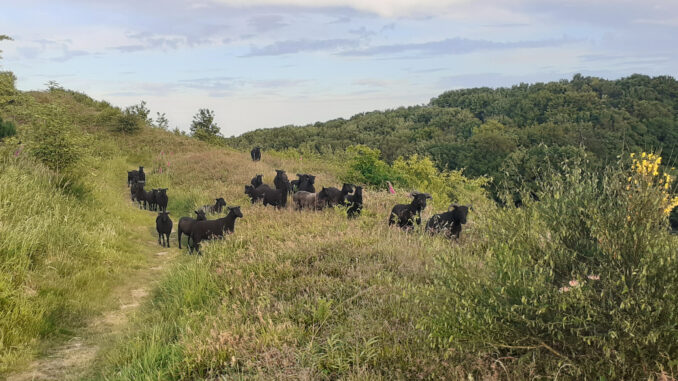
The country may have been on lockdown since March, but landscape maintenance at Old Oswestry hillfort has been boosted by the arrival of a new breed of helper.
Volunteers from the local community group, the Oswestry Heritage Gateway, have been working closely with English Heritage for over three years on a variety of landscape initiatives. These range from litter-picking and vegetation cutting to pond clearance and improvement, which has seen a healthy revival in frog and newt populations.
Now volunteers are delighted to see that an eye-catching flock of black sheep has taken up residence in the hillfort’s southern half to help tackle the problem of bracken overgrowth.
Helen Allen of English Heritage, guardians of the hillfort with responsibility for looking after the site, said: “Over time, bracken has re-established itself on the hillfort, which can cause damage to underlying archaeology.
“The scale of the site and steepness of the slopes make it hard to cut the bracken back, so we consulted with our grazier and a local agricultural college on sustainable solutions that could be integrated into our ongoing landscape management.
“As a result, we decided to experiment with intensive sheep grazing in conjunction with other mechanical means to control the bracken cover.”
Hillfort users are being asked to play their part by keeping dogs on the lead at all times when walking through the southern section, the side closest to Llwyn Coppy and the town. Dogs must also be under control when accessing or leaving the site at the western entrance which falls within the sheep grazing area.
Native to the British Isles, the Soay/Hebridean cross-breed chosen is hardy and thrives well on rough grassland and heath, making it popular for conservation grazing. The distinctive, horned breed is sometimes referred to as the Iron Age sheep, as it was probably the type farmed by our ancestors on hillforts like Old Oswestry and within the surrounding landscape.
Fencing and gates on the hillfort were repaired in preparation for the new arrivals at the end of May. Temporary notices have been installed to alert visitors to the changes and dog control requirements while permanent signage is being produced.
Plans for the sheep grazing along with other hillfort management activities and an expanded volunteers’ programme were shared with the public by English Heritage at an open meeting held in February at Oswestry’s Hermon Chapel hosted by Oswestry Heritage Gateway.
Bernard Walker, a landscape manager at English Heritage, said: “With the support of volunteers we have made great strides with our community-supported management programme at Old Oswestry over the past few years.
“The reintroduction of sheep grazing will be vital in continuing this progress, and with the cooperation of the public, will help us all to protect the hillfort’s legacy so that people can continue to discover and enjoy the site.”
The volunteer group has also organised a pollinator discovery day, herb walk and supported a 24-hour BioBlitz in 2017 – an ecological survey which identified over 500 species to update historical records of the hillfort’s flora and fauna.
Old Oswestry was built and occupied during the Iron Age (800 BC to AD 43) and is one of Britain’s best-preserved hillforts. Known as the ‘Stonehenge of the Iron Age’, the earthwork and its hinterlands have yielded prehistoric finds dating back over 4,000 years.
In recognition of its national heritage significance, the hillfort has been protected since 1934 as a Scheduled Monument while also being a Local Wildlife Site denoting its importance for ecological conservation. Additionally, it is located on one of Shropshire’s historic farmsteads and . forms part of the Oswestry Uplands National Character Area (NCA), among 159 natural areas in England defined by a unique combination of landscape, biodiversity, geodiversity, history, and cultural and economic activity.
Leave a Reply